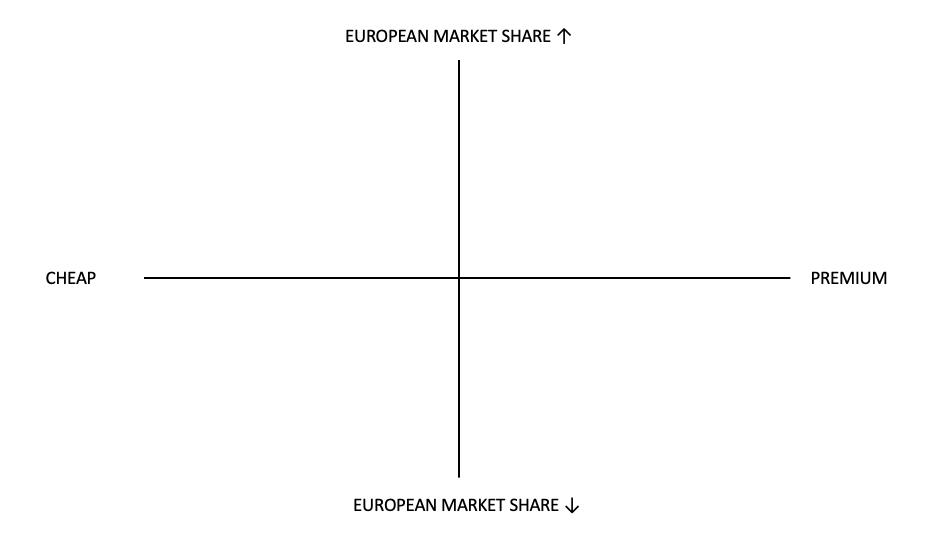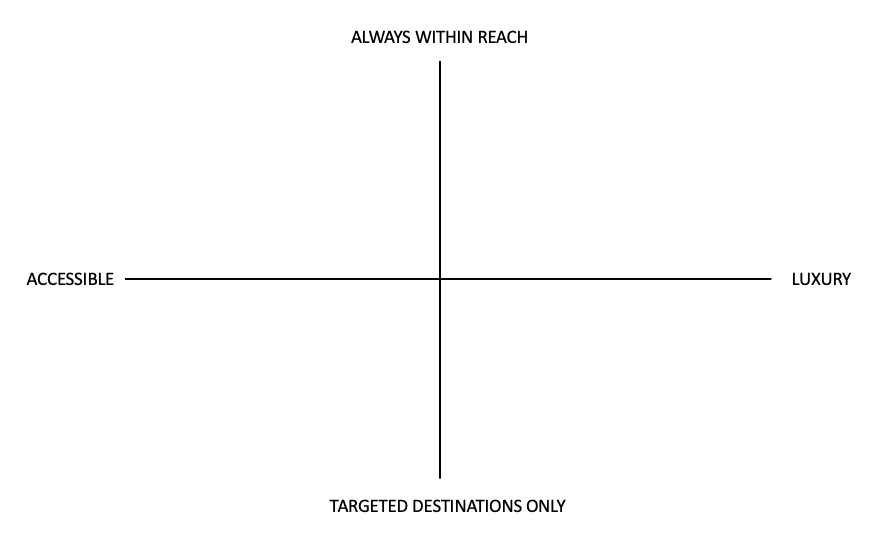
17 February 2021
Finding your bold space – the art of positioning
Founding fathers of brand ‘positioning’, Al Ries & Jack Trout, described it as ‘a new approach to communications in an over-communicated society’. They were New York City Madmen and this was 1972.
Positioning was never about the ‘what’ – e.g. the product, name or packaging. It wasn’t something you could make or do. It wasn’t even about the how or the why – e.g. best value, most innovative or ‘to inspire moments of happiness’. It wasn’t one benefit on its own.
Positioning was more abstract than that, harder to pin down. It was a collection of brand elements that added up to a perception.
Its intention? To conjure an instant impression in the mind of the consumer vs the competition.
It was a space to own in a relentless sea of noise. A shortcut.
It was never intended to be a functional structure, a prescriptive exercise, a grand ‘brand purpose’ or even something new in the mind of the consumer.
It was an emotional expression – at its best a way of addressing what the audience needs and retying existing brand associations in their minds.
Positioning was the antidote to Ries & Trout’s concern that basic advertising was rarely going to ‘change minds’; so you must own a ‘space’ at brand level, targeted and immediate – staking a claim for an audience and connecting with their cultural needs.
You must make them feel something, fast, by saying or showing what you stand for as quickly and definitively, in as few words or pictures as possible, enforcing a perception and making it a reality.
All communications should consistently, cohesively amplify the positioning. Again and again.
Today’s straplines, if done well, are perhaps the most similar to original positioning statements or ‘expressions’ of positioning (once called ‘positioning slogans’). They aim to distil the complex and turn a brand into a mindset or ‘essence’ vs the competition:
As true then – ‘Just Do It’ – ‘We’re No.2, so we try harder’ – ‘the Uncola’
As they are today – ‘Just Do It’ (still working!) – ‘Everyone’s private driver’ – ‘Belong anywhere.’
Positioning was not meant to just guide external comms however. It went much deeper than that, also intended to be a firm internal guide. Positioning allowed you to help the people within your business understand exactly what it was, who it was for and where it was going.
The importance of positioning in its purest form is as necessary in 2021 as it was in 1972 – but this crucial art form seems to have gotten lost in translation. Why?
Firstly, we have confused and complicated terminology to high heaven. Ask five strategists their definition of purpose, mission, vision, positioning, purpose statement, mission statement, vision statement, positioning statement and you will get 40 different definitions.
Today’s ‘positioning statements‘ are far more corporate, functional and aim to define every unique element of an offering at once, for example:
[Audience] For individuals looking for high-quality beverages, [Benefit] Coca-Cola offers a wide range of the most refreshing options — each creates a positive experience for customers when they enjoy a Coca-Cola brand drink. [Difference (and a bit of Purpose)] Unlike other beverage options, Coca-Cola products inspire happiness and make a positive difference in customers’ lives [Reason to believe] and the brand is intensely focused on the needs of consumers and customers.
Don’t get me wrong – these statements have great use – but they deviate from ‘positioning’ in its important, original, emotive, evocative sense.
Secondly, I so often see positioning charts that are void of any emotional or cultural connection i.e. two axes that are solely about the brand, not the audience, fully functional, one side with a clear negative slant e.g. ‘cheap vs premium’ and a focus on purely commercial elements e.g. a ‘European market share’ axis.
This is a woefully boring example of positioning that cannot benefit your brand in the mind of the audience:

A positioning must involve the consumer’s perception, it must incorporate culture (a moment, mindset, or situation) and it must evoke emotion (for B2B too, maybe even more importantly). No one in an audience cares about a brand’s European market share – and if they should, why? And that’s what’s on your axis.
And (again, whilst not the most dazzlingly exciting example) it starts to feel quite different if the chart with the exact same purpose says:

There are of course functional brand attributes that play a strong part in positioning a brand e.g. its price point – but in great strategy, like great creativity – whilst there is necessary structure in the system, for great work there must also be great freedom within the parameters which you search for and define the positioning within.
The positioning placement is the catalyst for defining the words. Definition which will be judged by emotion – Apple: ‘Think Different’.
Great positioning needs the freedom to combine: a brand’s offering, a compelling customer truth, a cultural setting with resonance, a little bit of tension – and find itself in the form of some very simple, very true, impactful words.
Positioning should allow, guide and amplify authenticity, and, equally shine a light on and destroy it when words misalign with actions or actions misalign with words.
Furthermore today, with access to deeper cultural insights through social media and social listening, deeper competitor analysis through online reviews, brand sentiment analysis, multiple communication channels and trend tracking – creating a compelling positioning is both possible and game changing.
At Boldspace we’ve built our combination of technology and creativity to achieve just this.
Propelling Ries & Trout’s 1970’s thinking into 2021 action, we fuse both trend and tracking data with our strategic and creative hearts and minds – to find a brand’s ‘bold space’ – a space in the mind of the consumer where it will win.
A quick tick list for when positioning either a brand or campaign:
- Research an audience in depth, online and in person
- Meticulously track the competition’s ‘perception’
- Make it about your audience, not your business
- Target culture
- Ensure at least one ‘emotional’ axis in all charts
- Explore until it feels ownable
- Show movement / direction on your positioning charts
- Put it into words
- Simplify it
- Simplify it again
Get in touch with Boldspace
The brands of today must change and adapt to the evolving needs of customers and the market. Those who are agile and react quickly will win.
If you’re exploring your brand positioning or want to navigate your brand strategy, we would be delighted to discuss our thoughts with you. Please do get in touch.